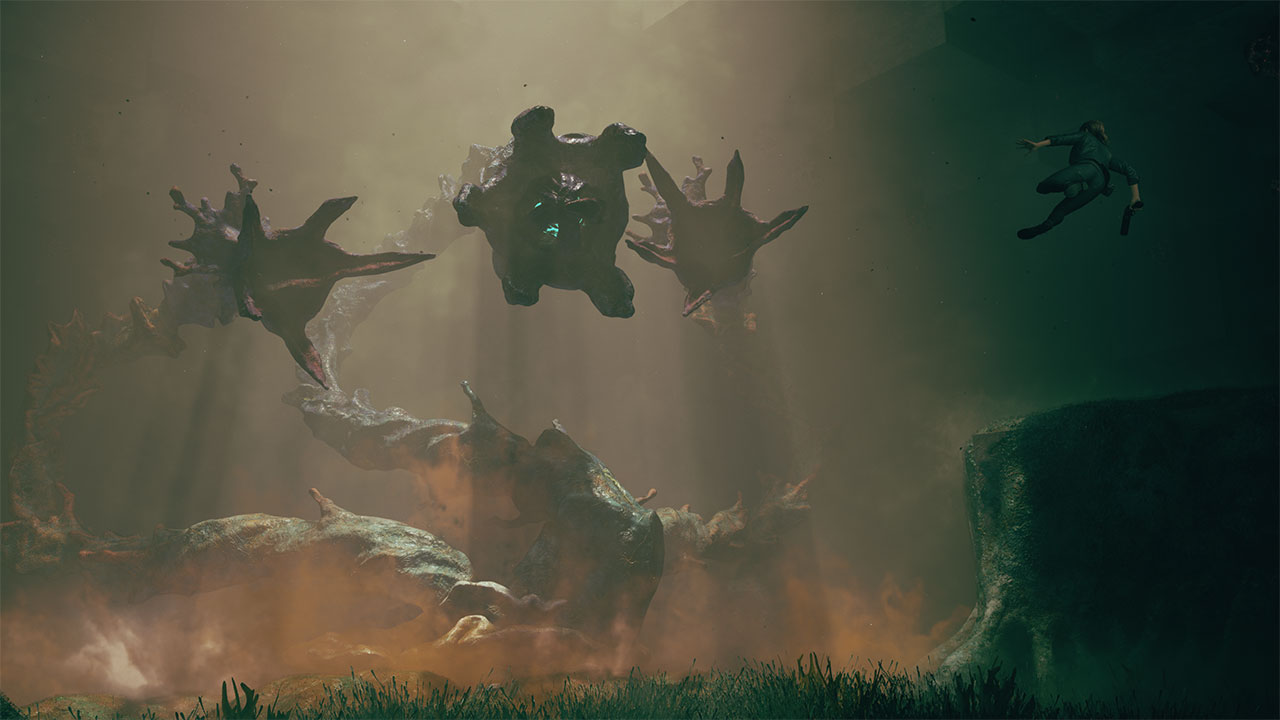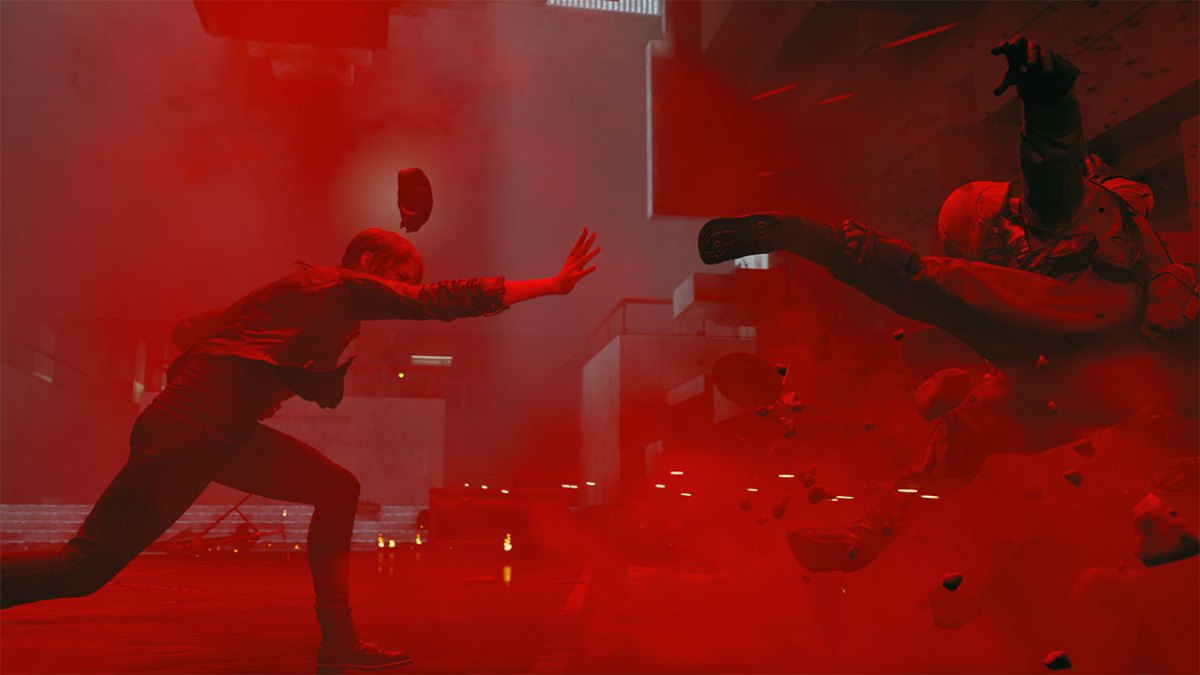Remedy Games hasn’t made that many games in the past 20+ years the developer has been around, but each time that they do release one it’s been pretty special. While this is the studio that brought you the original Max Payne games, Alan Wake, Quantum Break, and now Control… each of these games has brought something new to the table. Whether it was the new gameplay mechanics of bullet-time or Alan Wake’s flashlight, things have always been somewhat interesting when it comes to the gameplay mechanics of Remedy games. Control is no different, it certainly stands out from other products that Remedy has released over the years, but also feels very familiar to their most recent offerings in Alan Wake and Quantum Break.
It’s the kind of weird that you’ve come to expect from the developer
Remedy has established themselves as the developers that make weird, stylish games. This has done well with the last two aforementioned series’. They jumped into the world of FMV in their games, blurring the lines between fantasy and reality. Control is definitely another one of these. It’s a weird mess of a story that places you in the shoes of a young woman who finds herself in a place called the Oldest House, which happens to be a hidden building in the middle of New York City where a supernatural threat of the Hiss looms. You become the new Director of a group called the Federal Bureau of Control and can wield a supernatural firearm called the Service Weapon which is your main source of gameplay as it is a third person shooter. The Hiss are everywhere in the Oldest House and they have the ability to take over and possess the other agents in the building. The story winds and turns with a little bit more about who you are and why you are there, but it really stays fairly mysterious up until the credits roll.

Less Linear than you’ve seen from Remedy in the past
Control is a little bit less linear than other Remedy games. There’s a massive, multi-level map to explore, with numerous NPC characters to meet, side quests to tackle, blocked passages, and loot to uncover. There are some aspects of a Metroid-vania style game here, but they are light. There are Security Doors which require key cards and some areas can’t be accessed without having specific powers, but it never feels not obvious what you need to do. Most of the stuff that is locked behind abilities really does just add more color to the world. While the key cards are usually story items that you’ll get in a fairly linear fashion. The video gamey bits are what keep you pushing forward in Control, but it’s also an incredibly stylish game with a dark weirdness to it. The imagery, sounds, and general presentation and mysterious story pull you in immediately as we found ourselves really wanting to learn about this world. Unfortunately, everything does stay pretty vague in Control. After watching the credits roll, I thought it was definitely worth the time spent, but I did feel a little unfulfilled in so much being left to collectible files that you can read or FMV videos that you can watch along your journey.
Shooting and abilities give the combat some variety
Control is a third person shooter, but it’s not just a shooter. There are plenty of abilities to learn as the Director. Your supernatural abilities allow you to stabilize objects of power which you can then draw abilities from. You’ll learn things like double jumps, levitation, telekinesis, and others which allow you to fight different types of enemies or reach different areas of the map. Control is far-less linear than Remedy’s previous games. There is the main path of the story, which you can really barrel down if you want. But, there’s also a good bit of side content in this game. Some of the side content is actually much more interesting than the actual main path and you’ll really miss some cool stuff if you don’t explore this world. For example, the Hiss are the major threat in the game. But, there are also others which a scientist is researching in an area called the Pit. You don’t need to visit the Pit to beat Control, but if you do you’ll get treated to a massive boss fight against a giant mold monster. It’s stuff like this that make Control tough to digest. Some of this side content is definitely must see, but putting off of the main path does make it unlikely that many will encounter it. The rewards, whether on the main path or when exploring is points and materials to upgrade your character and weapons.

These points will funnel into your different abilities, making the stronger across the course of the game. As you spend your trait points you will unlock more mod slots for your weapons and personal buffs. The combat in Control is a mix between third person shooter and an ability focused game. You’ll definitely be shooting your fair share of enemies, but you can also upgrade your different abilities to use a telekinetic push melee or unlock the ability to pick up and hurl items with your mind. You can summon items around you as a shield, or levitate over the battlefield while raining down abilities or bullets. The combat is varied and putting all of the abilities together really make it stand out. This really doesn’t start clicking until you’re pretty deep into Control though. The early parts are certainly more bullet-based, while the latter stages are focused on your powerful abilities or juggling back and forth between the two. As enemies get tougher you’ll manage your ammunition in Service Weapon and your energy to use abilities. I found myself in familiar patterns again and again. Since there is no reload and everything runs off of a charge in Control, it always basically felt like I was shooting until I need to recharge the weapon and then using my abilities until the energy ran out. By the time that energy ran out I was swapping back to the service weapon to repeat the process. That coupled with dodging and levitating mechanics gave the combat a nice rhythm. Control on the Xbox One did feel kind of like a PC game that was ported to consoles. The aiming and targeting felt a bit rigid and not quite as smooth as some other third person shooters or action games. Control does feature some incredible destruction physics in combat and in exploration phases. The destruction makes all of your powers and abilities feel real and have a lasting impact on the world around you.
Main path story missions, side content, challenges, and agency missions… there is no shortage of things to do
Control is kind of structured in a unique way for a single player experience. There are your aforementioned story and side mission content, but there are random missions where you’re given objectives that must be completed in a certain amount of time. They feel almost like a “daily challenge” that you’ll find in a multiplayer game. There are challenges that can be tackled for rewards as well. Kill a certain number of enemies without dying in a certain part of the Oldest House, and you’ll reward you. Control definitely takes some of the engaging content from multiplayer games in terms of challenges and introduces them in a way that makes sense for a single player game. The rewards are upgrade points and materials that will allow you to craft personal mods, weapon mods, and different weapon forms for the Service Weapon.
The Service Weapon does start out as a pistol, but it can evolve into multiple things. While the actual size and shape of it changes only slightly, the firing mechanics and bullets that come out of it differ drastically from a beam to a burst rifle, or shotgun. So long as you’re spending points on upgrading the weapon you’ll have no shortage of ways to kill enemies. You can equip two of the weapon forms at once, and then outfit the weapon with up to three different mods which give you various buffs that compliment your playstyle. There’s no shortage of these progression and upgrade items Control. In fact, there’s actually quite a lot of loot in the game if you’re looking for it. There is a nice ramp of progression in the game from start to finish where the abilities that you learn and weapons you are using definitely make you feel more powerful in the end game than you did when you were bumbling around the halls of the Oldest House trying to piece together why you are there in the first place.

We played it on the “world’s most powerful console” and it was kind of a mess
Control is definitely a stunner when it comes to visuals and presentation, but on a technical level on the Xbox One X the game really feels like its pushing the console to its limits. Taking away from the fun at times were smaller things like the map not loading when trying to pull it up until waiting for 15-20 seconds. This in itself makes navigating the world more of a chore than it has to be. Then there’s fast travel and loading into a new control point. These points are effectively the checkpoints in the game and when you reach one or rest at one you’ll respawn from there if you happen to die. Each and every single time I loaded into a new control point there was significant frame rate drops and slow down that was visible on screen on the Xbox One X. It’s became pretty disappointing as the game got harder because it was a stark contrast from the rest of the game. That’s not to say that Control didn’t chug at other spots. Put too many enemies on the screen and the Xbox One X just felt like it was overloaded with the enemy counts and the ongoing effects. It didn’t take away from my experience too much, but it’s definitely noticeable in a game as stylish as Control.
Anyone that liked or loved the Quantum Break or Alan Wake games will most certainly enjoy Control. Remedy has certainly embraced their artistic sides for this game, taking more risks with their story telling than their last couple of games and doubling down on their penchant for including live actors as a story telling device. If you’re not quite sure what to expect, it’s a dark, twisted, weird world full of things that don’t make any sense. At times this feels ok, and refreshing that you don’t quite know where it’s going to end up, but it can be a little disappointing. One thing’s for sure, it’s definitely a hell of a ride from start to finish.
The Verdict
Control is definitely Remedy’s best game since Alan Wake. The sheer variety in the gameplay and fantastic presentation go a long way in making this an enjoyable experience. The weird story and setting does a great job of setting the hook at the onset, but the payoff was a little underwhelming.











Published: Aug 26, 2019 08:00 am